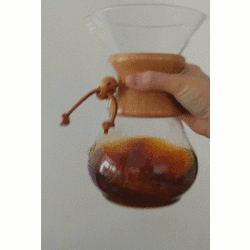Wow, I still can’t believe it, but it happened – I won the International Chemex Cup. Thank you so much Coffeecircle for organizing this great event, a big thank you to all the amazing participants and everybody involved, it was a blast! And thank you to everyone who asked about my recipe, that is really sweet!
And here it is comes. Well, first a spoiler: I think the recipe might be very tailored to the competition coffee and not necessarily work with any other coffee – but just try and share your experience, I’m excited to hear all about it!
The preparation for the Chemex Cup was a work in progress, so I’ll let you in on my journey with this special coffee. All participants received a bag of the competition coffee – a washed Ethiopian coffee from the Guji zone – in advance. We knew that the coffee that we would use at the competition would be 7 days old, so I arranged to practice the day on which our training coffee was also seven days after roasting.
start: cuptasting
So far, so planned, everything else was a little more trial and error. I started like always with a plain old cuptasting of the coffee to get to know it a little. What I tasted were black tea notes and a nice sweetness. On the other hand I noticed the challenge of this coffee could be managing the bitterness (that comes with the black tea notes) and the body (it was very light already).
Since I don’t have any fancy equipment to measure the extraction of my brews, I had to rely on two things: my taste buds and other people’s feedback to my taste. At last year’s Chemex Cup for example, I got the feedback from the jury that I tend towards overextracting my coffees. That was good to know and I tried to incorporate that in future brews.
grinder settings and agitation
So I started with my usual Chemex recipe and a medium coarse 23 grind setting on my Comandante. The body was nice, but the coffee much too bitter for my taste. So I went coarser, still too bitter, coarser again. By the time, the bitterness was not too overwhelming, the body of the coffee was gone. So I tried to improve it by using agitation. First, I stirred the coffee grounds during the bloom and then I added a few shakes after the first and the third pour. I really don’t know if that was the right thing to do (see above – taste buds only), but I liked it better. There you go. That was how I went to a really coarse grind setting and a lot of agitation.
filter-fold
Another thing I was asked about a lot is the folding technique of the Chemex filter. The only reason I am doing this is for a better control of the brew. But then again, it is not “my” folding technique – I had the honor of learning this filter fold from last year’s Chemex Cup winner, Haider Adams. It was completely new to me that there’s the possibility of speeding up your pour by pulling the opposite edges of the filter. This reduced contact time between water and coffee grounds helped big time reducing bitterness.
How to fold? Just fold the (in the box already twice folded) filters one more time (45 degree angle) and open it up again so that you have two double layers on opposite sides. One of the double layers should be placed over the spout (just like when using the filters out of the box).
water
As for the water (quality): I trained with Volvic and local tap water (good quality, very soft), thought about changing it, but didn’t. At the competition I used the provided water at coffeecircle (Brita filtered). For the bloom, I used slightly colder water. The exact temperature(s) and times you’ll find below at the recipe description.
conclusion
All the folds, coffee shaking, coarse grinding and cold blooming are just a way to interpret this special coffee with all the goodness it already has. So the biggest compliment for me was that Ersin Koray, who roasted the coffee at coffeecircle, liked my coffees best throughout all the rounds of the competition. And that’s really all you can do when you brew: try to make all the people proud who made your coffee – the farmers, the ones who pick the perfect cherries and everyone involved up until the thoughtful roasting process.
Now, if you like, please enjoy the recipe and let me know how it worked for you!
Chemex Cup 2018 – winning recipe
- 20 grams coffee (please add one or two extra beans for the always hungry grinder)
- 310 grams water (93 degrees, Brita filtered water)
-
fold paper filter and rinse it thouroughly

-
grind your coffee coarse (I used 28 on my Comandante)

-
bloom with slightly cooled water (60 – 70 degrees), 50 grams, 45 seconds (stir the grounds)

-
first pour to 120 grams (until 1:40) – give it a shake
-
second pour to 180 grams (until 2:30)
-
third pour to 240 grams (until 3:20) – shake it one more time
-
fourth pour to 310 grams – lift filters for quicker flow at 3:45 – end brew at 4 minutes

-
now shake it, baby! (just kidding – the vivid shaking was just to cool the coffee a little down after brewing, because I liked the taste better a tad cooler)

* Links in the article include affiliate links


Hi,
I don’t really understand the folding technique.
You use two filters ?
Do you have any détails pics for that ? Thx.
Hi Xavier,
it is one normal folded Chemex Paper Filter and I fold it one additional time (like shown in picture 1). If you lay it out flat on the table, normally you have a 90 degree angle, and after the fold you would have a 45 degree angle. Then open it up and put one of the double layers over the sprout (like where you would also normally place the double layer) and the other double layer on the opposite site.
I hope that helps 🙂
Cheers,
Ruth.
Hi Ruth,
Have you had any trouble with an increase in papery taste when you lift the filter folds to increase the flow rate? Currently trying to dial in a coffee and am considering this method.
Thanks!
Hi Austin,
that is a tricky question…. I would say it is between two evils where you chose between the chance of a too slow flow that adds bitterness and on the other hand the chance of a slightly increased papery taste.
For me, it wasn’t really too bad with the papery taste. The only problem I might see with the pulling of the filters is the exact replication (in case you always want to land on the same TDS) that is (in my opinion) always a bit tricky with manipulations during the brew.
Hope that helps.
Cheers
Ruth
I don’t get the folding instructions either; even after you 2nd explanation.
Hi Jay,
is your question regarding the fold as such or where to put the doublel-layers when putting the filter inside the Chemex?
Cheers,
Ruth
Gute Anleitung. Ich verwende immer die naturbelassenen braunen Filter von Chemex. Vermute mal dass die weißen geschmacksneutraler sind oder?